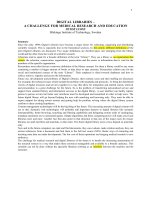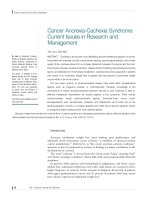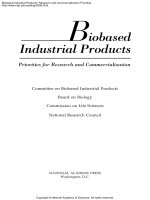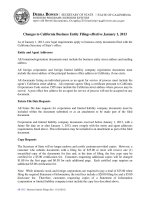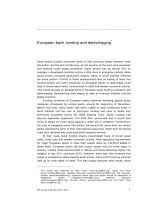EU research and innovation funding – immediate changes to cut red tape for researchers and SMEs ppt
Bạn đang xem bản rút gọn của tài liệu. Xem và tải ngay bản đầy đủ của tài liệu tại đây (35.78 KB, 7 trang )
MEMO/11/38
Brussels, 24
th
January 2011
EU research and innovation funding – immediate
changes to cut red tape for researchers and SMEs
Why is simplifying research funding important?
Research and Innovation are at the core of the EU's Europe 2020 strategy for growth
and jobs as set out under the Innovation Union flagship initiative.
A pre-requisite for delivering the best results is that research programmes are highly
attractive and accessible to researchers, European industry and entrepreneurs,
universities and other research and innovation actors.
This requires clarity of objectives and instruments, consistency and stability of rules,
and lightness and speed of administrative procedures.
The improvement adopted will feed through into better research results, achieved
more efficiently, and lead to new products and services that will create new sources
of growth and jobs.
European Framework Programmes invest large sums of money – well over €50
billion between 2007 and 2013 for the Seventh Framework Programme alone - and it
is very important, not least in a time of austerity, to get the best possible value for
every euro spent.
How did the rules get so complicated in the first place?
Over 25 years, the scope and budget of the EU's Research Framework Programme
has expanded significantly. This resulted in more participants and more diverse
funding schemes and, of course, a need for more controls to ensure that the EU
funds are spent correctly. Moreover, changing political and economic priorities have
led to ad-hoc actions with different sets of conditions to promote particular areas of
research or research sectors. Thus, a number of different rules and administrative
procedures were developed to optimise European effort in research, but participation
in EU-funded projects became more complex.
More broadly, simplification also requires bridging the gap between funding rules and
principles specific to the Framework Programme and a wide range of accounting
practices used for other purposes by the research organisations and businesses that
participate.
2
What are the main changes being made now?
Firstly, there will be more flexibility in how personnel costs are calculated so that EU
research grant-holders can apply their usual accounting methods when requesting
reimbursement, based on average personnel costs.
Secondly, SME owners whose salaries are not formally registered in their accounts
can now be reimbursed through flat-rate payments for their contribution to work on
research projects. For this purpose the Commission has set up system of flat-rate
allowances already applied in the Marie Curie research grant scheme. The hourly flat
rate for a researcher will mainly depend on his/her experience and country of
residence. For instance hourly rates applicable in 2011 for researchers established in
Belgium will vary around €24 for early stage researchers to about €55 for very
experienced researchers.
And thirdly, a new steering group of senior officials from all the Commission
departments and agencies involved will remove inconsistencies in the application of
the rules on research funding.
How does the reimbursement of personnel costs work ? Can you give
an example of how it will change ?
A general principle governing EU research funding was that beneficiaries claim
actual
costs for the resources employed on the EU projects. For personnel costs this
meant that grant holders had to calculate the payroll cost of each individual
researcher for the time (usually expressed in hours) spent on the project. Very often
this meant that they had to introduce a parallel method of calculating personnel costs
for their participation in EU research projects, which was incompatible with their own
practice and actually increased their costs.
The new changes allow them to group personnel in categories based on objective
criteria (experience, seniority, level of salary, department, etc). The grant holder
calculates an average rate based on the salaries of the employees within each
category or group This average is then used to charge the personnel costs to the
projects by multiplying the average rate by the hours dedicated to the project under
each category or group regardless of the actual costs of the individuals who
performed the work (which could be higher or lower than the average).
Here is an example. One category could include two researchers: researcher one
with a salary of €48.000 and researcher two with a salary of €36.000. The total cost
of the category is €84.000 and the total hours worked in the year are, for instance,
3360 (1680 * 2 researchers). The average hourly rate of the category would be €25
(84.000 / 3360). Whenever the department collaborates in a project, the hours are
charged at €25 irrespectively if it is researcher one or researcher two who actually
performs the work. For certain beneficiaries, categories could include dozens of
researchers and, thus, the average system is for them a real simplification in the
calculation of costs.
How much money will these changes save?
Up to now grant holders who use average personnel costs, including SME owners
and natural persons without a salary in the accounts, were obliged to produce a
certificate on how they calculated their personnel costs. These certificates cost
around two to three thousand euro in the simplest cases rising considerably for large
institutions with complex structures. Moreover, beneficiaries frequently had to
dedicate additional time and money to adapt their personnel costs calculation
methods to the requirements of the Commission to obtain the approval of their
methodology.
3
How much time will these measures save ?
It is impossible to quantify in advance but cumulatively, across the thousands of
projects affected, a great deal of time will be saved. For example the new rules on
accounting for personnel costs will make it easier and quicker for participants to
compile and submit reimbursement claims and easier and quicker for the
Commission or the Research Executive Agency to process those claims and get
payments made.
Will existing projects be affected by the changes, or only new ones?
In most case the Commission will allow participants in ongoing projects under the
Seventh Research Framework Programme (FP7) to benefit immediately from these
changes. The measures are designed in such a way that their retro-active
application does not cause additional burden for beneficiaries.
Why has it taken since April to bring these changes forward?
The Commission has to guarantee the maximum level of simplification without
undermining the sound financial management of European taxpayers' money.
Therefore, an extensive analysis was needed on the impact of the new measures,
from both financial and legal points of view.
Moreover, based on the Commission communication on simplification from April
(see IP/10/472
and MEMO/10/156 and
broad
inter-institutional discussions with the Council and the European Parliament took
place to jointly determine the best approach.
How will the Commission ensure that these changes do not lead to a
risk of reducing effective financial control?
As the European Court of Auditors indicated in its most recent Annual Declaration of
Assurance for the EU budget, simpler and clearer rules and procedures reduce the
scope for error and increase assurance on the legality and regularity of expenditure.
The new rules adopted are clearly defined in a transparent and unequivocal manner
providing, in addition, a realistic balance between trust and control. The Commission
is fully committed to ensuring sound financial management of European research
policy.
Do these changes fully reflect the recommendations of the Mid-Term
Evaluation? (See IP/10/1525)
Yes. The recommendations of the interim evaluation of FP7 were fully considered
when designing these short-term simplification measures. More profound changes
suggested in the report, which would require an adaptation of the overall legal
framework, will be tackled in the Commission proposal for the rules of the next
research and innovation programme.
4
What progress has been made towards simplification so far?
Important progress has already been made over the last few years. Some measures
for simplification were already included in FP7 from the beginning, as compared with
previous Framework Programmes. Others are the result of the Commission's
ongoing efforts to improve the rules and procedures.
On the basis of 150 FP7 calls, there has been a significant reduction in "time-to-
grant" - the interval between the deadline for bidding for funding in response to a call
for proposals and the signature of a grant agreement - if compared with FP6 calls.
The overall median (the interval after which half of all grants in a call are signed) in
FP7 is currently 330 days, i.e. 30 days (or 10%) shorter than in FP6.
Achievements in FP7 include:
- A considerable reduction of ex-ante controls to ease the participation of SMEs
and high-tech start-ups. 80% of FP7 participants are completely exempt from an
ex-ante financial capacity check.
- A major reduction of the number of audit certificates to be submitted covering
the costs charged to the research projects. Contrary to FP6 where all
participants had to submit at least an audit certificate for the project, 75% of FP7
participants are exempt from providing such certificates. Since each certificate
costs between some hundreds and several thousand euro, these exemptions
are leading to saving of tens of millions of euro compared with FP6.
- The introduction of a single registration facility. Applicants no longer have to
supply the same information every time they take part in a new grant
application.
- A streamlining of reporting requirements
- Improvements to IT tools ("e-FP7")
- Improvements to the service and guidance offered to applicants
Will there be more changes before the end of FP7?
No further radical changes should be expected for FP7. The continuity of the rules in
place is also important for participants in FP7 and this in itself avoids uncertainty.
However, certain additional measures could still be implemented, such as the
removal of the requirement for beneficiaries to hold interest-bearing bank accounts.
This measure would lift the current obligation to open such bank accounts for
managing the pre-financing funds paid by the Commission. This requirement implies
in certain cases an important administrative burden for a number of beneficiaries.
Nevertheless, the measure is part of the proposals for the new Financial Regulation
applicable to all EU programmes, which are being currently discussed with
Parliament and Council. Therefore, it cannot be treated separately only for research
actions. A positive outcome of these discussions will lead to the removal of this
requirement.
5
What kind of changes can we expect under the next research
programme?
The Commission is committed to adopting the proposals for the legal framework for
the next programme by the end of 2011. A full public consultation based on a Green
Paper will be launched during the first quarter 2011. Further substantive
simplification will be a key priority for future research and innovation funding. A
measure with a far reaching potential for simplification is the establishment of a
single set of consistent rules for all participants, to provide predictability for
participants. Other avenues that will also be explored include the simplification of the
complex matrix of different funding rates, the introduction of more flat rate payments
and simpler methods for determining indirect costs. Moreover, the broad acceptance
of the usual accounting practices of participants should become the general rule.
Why not make some of these changes now?
Simplification is not just a question of what can be done under the Research,
Innovation and Science portfolio. All Commission programmes are governed by the
same financial regulation. Commissioner Lewandowski has put forward proposals to
amend this to allow more flexibility. Some of the measures we want to apply for
research funding depend on Council and Parliament decisions, and on whether they
will allow an increase in Tolerable Risk of Error in certain fields, including research
projects.
What is Tolerable Risk of Error?
Financial transactions can rarely be absolutely free of risk of error, especially in
projects which may have dozens of participants and last several years and where
accounting procedures are necessarily complex.
The purpose of the Tolerable Risk of Error (TRE) is to ensure a proper balance
between the extent of controls and the effectiveness of policy. The error rate is
(roughly) defined as the relation between the amount of costs incorrectly declared
and the overall costs (in a project, a collection of projects or a whole programme).
Reducing error rates requires increased control, including very detailed audits taking
place after projects have concluded. This is in turn costs money and staff time. For
each policy area, the Commission will strive to agree the most appropriate TRE with
the Budgetary Authorities. Under the current system, the risk of error is 2% for all
policy areas, regardless of the size of the projects or the complexity of the specific
rules. By slightly raising the Tolerable Risk of Error for research and other projects to
between 2% and 5%, as Commissioner Semeta is proposing, controls could be more
effective while also saving money and reducing bureaucracy. Currently, the
administrative cost of recovering – or reimbursing to projects - tiny amounts of
money based on minimal errors discovered during the audit process can sometimes
far exceed the sums collected or reimbursed.
Errors should not be confused with fraud or deliberate misrepresentation, which is
always referred to OLAF, the EU's anti-fraud office, and will continue to be referred
there.
6
What is the state of play in the discussions with the European
Parliament and the Council over the Financial Regulation and the
Tolerable Risk of Error (TRE)?
Discussions on the revision of the Financial Regulation are still ongoing. 1 January
2012 remains the target date for the entry into force of the revised Regulation. As
regards the TRE, the Commission has initiated an in-depth and continuing debate
with its Communication to the European Parliament, the Council and the Court of
Auditors on "More or less controls? Striking the right balance between the
administrative costs of control and the risk of error" of 26 May 2010.
( />3-0.Pdf) The European Parliament has, however, already expressed its full support
for the adoption of a higher rate of tolerable risks of error for research activities.
Which departments and agencies of the Commission are directly
involved in running FP7?
The departments of the Commission directly involved in running FP7 are:
Directorates-general:
Research and Innovation
Information Society and Media
Mobility and Transport
Education and Culture
Enterprise and Industry
Energy
Agencies:
ERCEA (European Research Council Executive Agency),
REA (Research Executive Agency)
How will setting up a new committee of Directorates-General simplify
things or achieve consistency?
Research programmes are implemented by different Directorates General and
Agencies with a large degree of decentralization. This has major advantages in
terms of flexibility and speed of decision-making but has also led, unfortunately, to
rules and procedures being applied in different ways in different areas. This has
sometimes created confusion for beneficiaries and can even discourage them from
re-applying for support. So the Commission is establishing the new committee to
help iron out these inconsistencies.
7
When will this new committee start work and when do you expect it to
deliver results?
The new Committee will be operational immediately and will deliver results on
relevant issues in a continuous manner. The Committee will meet upon request of
the Directorates-general when a controversial issue is raised. Resources for
secretarial and technical support have been put in place, and the necessary steps to
define the working procedures of the Committee are already underway.
EU research funding represents 5% of overall public funding in Europe
- what steps are being taken to simplify and streamline national
funding? How is the Commission involved?
National research funding procedures are compartmentalised in 27 different systems
which have evolved separately. Simplifying these national rules is an obvious way of
reducing the complex array of different conditions and funding schemes that
European researchers are facing. In early 2010, the Commission established a
Stakeholder Platform with key EU research funders and beneficiaries, to draw up
common principles governing research funding across the EU.
Thanks to Commission programmes such as the Marie Curie scheme and initiatives
such as the Researchers Charter, European researchers have better access to non-
national programmes and better mobility. They are however facing complex barriers.
Simpler rules for the Framework Programme will set benchmarks for national
programmes based on best practice.
How close are we to the 15% target for SME participation in the parts
of the Framework Programme for which they are eligible?
The latest figures have shown a participation of SMEs around 14.7 %. Although the
situation has improved, there are still efforts to be made. The Commission expects
that the new simplification measure adopted for SME owners without a salary will
further promote participation from this key economic sector.
(see also MEMO/10/156
)
